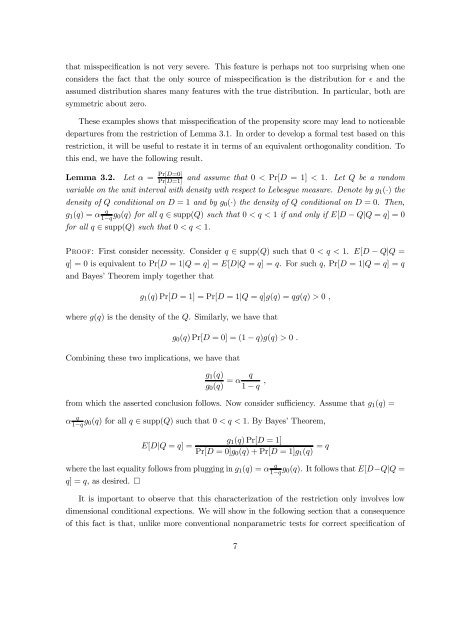On the Identification of Misspecified Propensity Scores - School of ...
On the Identification of Misspecified Propensity Scores - School of ...
On the Identification of Misspecified Propensity Scores - School of ...
Create successful ePaper yourself
Turn your PDF publications into a flip-book with our unique Google optimized e-Paper software.
that misspecification is not very severe. This feature is perhaps not too surprising when one<br />
considers <strong>the</strong> fact that <strong>the</strong> only source <strong>of</strong> misspecification is <strong>the</strong> distribution for ǫ and <strong>the</strong><br />
assumed distribution shares many features with <strong>the</strong> true distribution. In particular, both are<br />
symmetric about zero.<br />
These examples shows that misspecification <strong>of</strong> <strong>the</strong> propensity score may lead to noticeable<br />
departures from <strong>the</strong> restriction <strong>of</strong> Lemma 3.1. In order to develop a formal test based on this<br />
restriction, it will be useful to restate it in terms <strong>of</strong> an equivalent orthogonality condition. To<br />
this end, we have <strong>the</strong> following result.<br />
Lemma 3.2. Let α = Pr[D=0]<br />
Pr[D=1] and assume that 0 < Pr[D = 1] < 1. Let Q be a random<br />
variable on <strong>the</strong> unit interval with density with respect to Lebesgue measure. Denote by g1(·) <strong>the</strong><br />
density <strong>of</strong> Q conditional on D = 1 and by g0(·) <strong>the</strong> density <strong>of</strong> Q conditional on D = 0. Then,<br />
g1(q) = α q<br />
1−q g0(q) for all q ∈ supp(Q) such that 0 < q < 1 if and only if E[D − Q|Q = q] = 0<br />
for all q ∈ supp(Q) such that 0 < q < 1.<br />
P: First consider necessity. Consider q ∈ supp(Q) such that 0 < q < 1. E[D − Q|Q =<br />
q] = 0 is equivalent to Pr[D = 1|Q = q] = E[D|Q = q] = q. For such q, Pr[D = 1|Q = q] = q<br />
and Bayes’ Theorem imply toge<strong>the</strong>r that<br />
g1(q) Pr[D = 1] = Pr[D = 1|Q = q]g(q) = qg(q) > 0 ,<br />
where g(q) is <strong>the</strong> density <strong>of</strong> <strong>the</strong> Q. Similarly, we have that<br />
g0(q) Pr[D = 0] = (1 − q)g(q) > 0 .<br />
Combining <strong>the</strong>se two implications, we have that<br />
g1(q) q<br />
= α<br />
g0(q) 1 − q ,<br />
from which <strong>the</strong> asserted conclusion follows. Now consider sufficiency. Assume that g1(q) =<br />
α q<br />
1−q g0(q) for all q ∈ supp(Q) such that 0 < q < 1. By Bayes’ Theorem,<br />
E[D|Q = q] =<br />
g1(q) Pr[D = 1]<br />
= q<br />
Pr[D = 0]g0(q) + Pr[D = 1]g1(q)<br />
where <strong>the</strong> last equality follows from plugging in g1(q) = α q<br />
1−q g0(q). It follows that E[D−Q|Q =<br />
q] = q, as desired. <br />
It is important to observe that this characterization <strong>of</strong> <strong>the</strong> restriction only involves low<br />
dimensional conditional expections. We will show in <strong>the</strong> following section that a consequence<br />
<strong>of</strong> this fact is that, unlike more conventional nonparametric tests for correct specification <strong>of</strong><br />
7
















